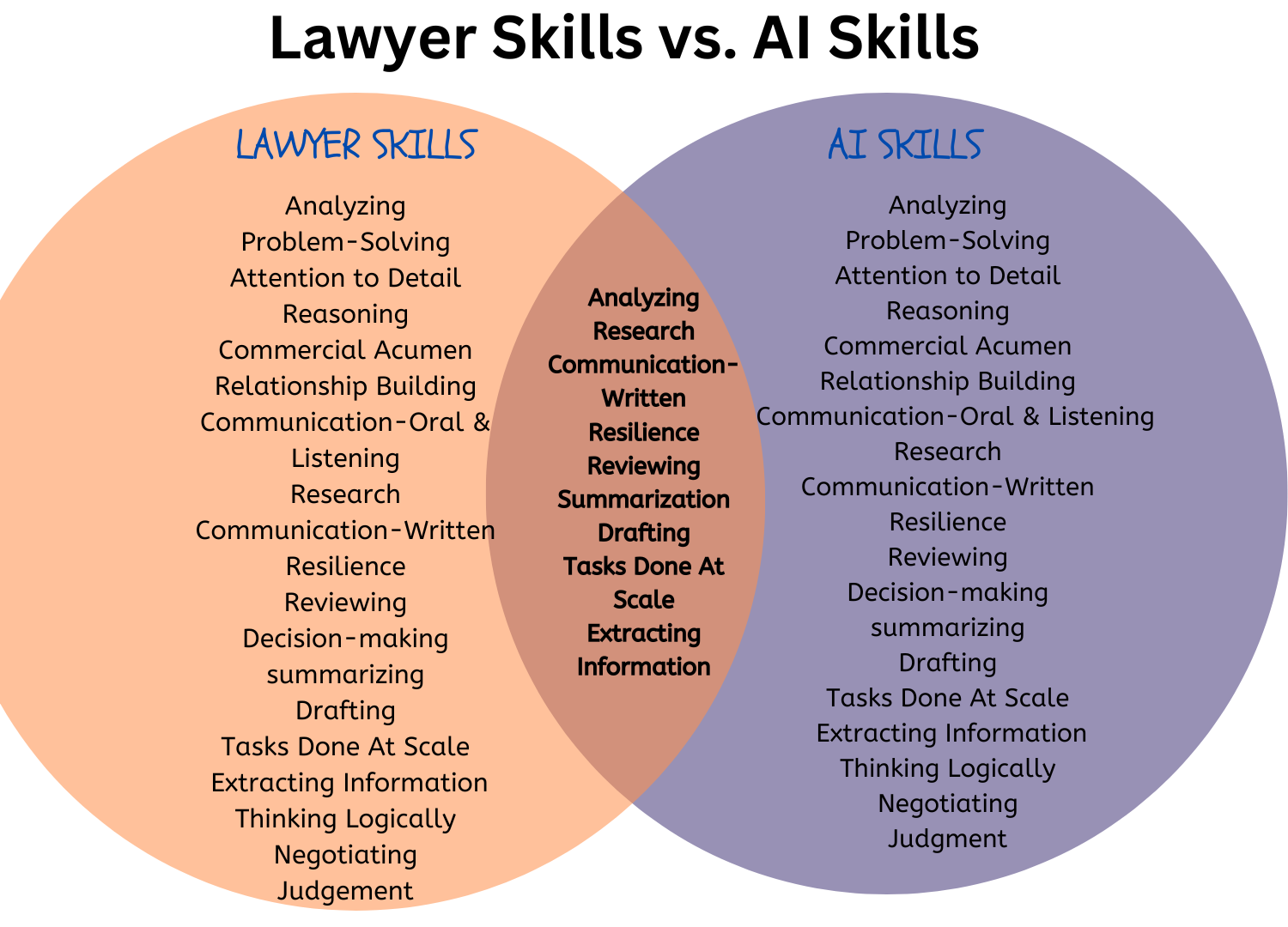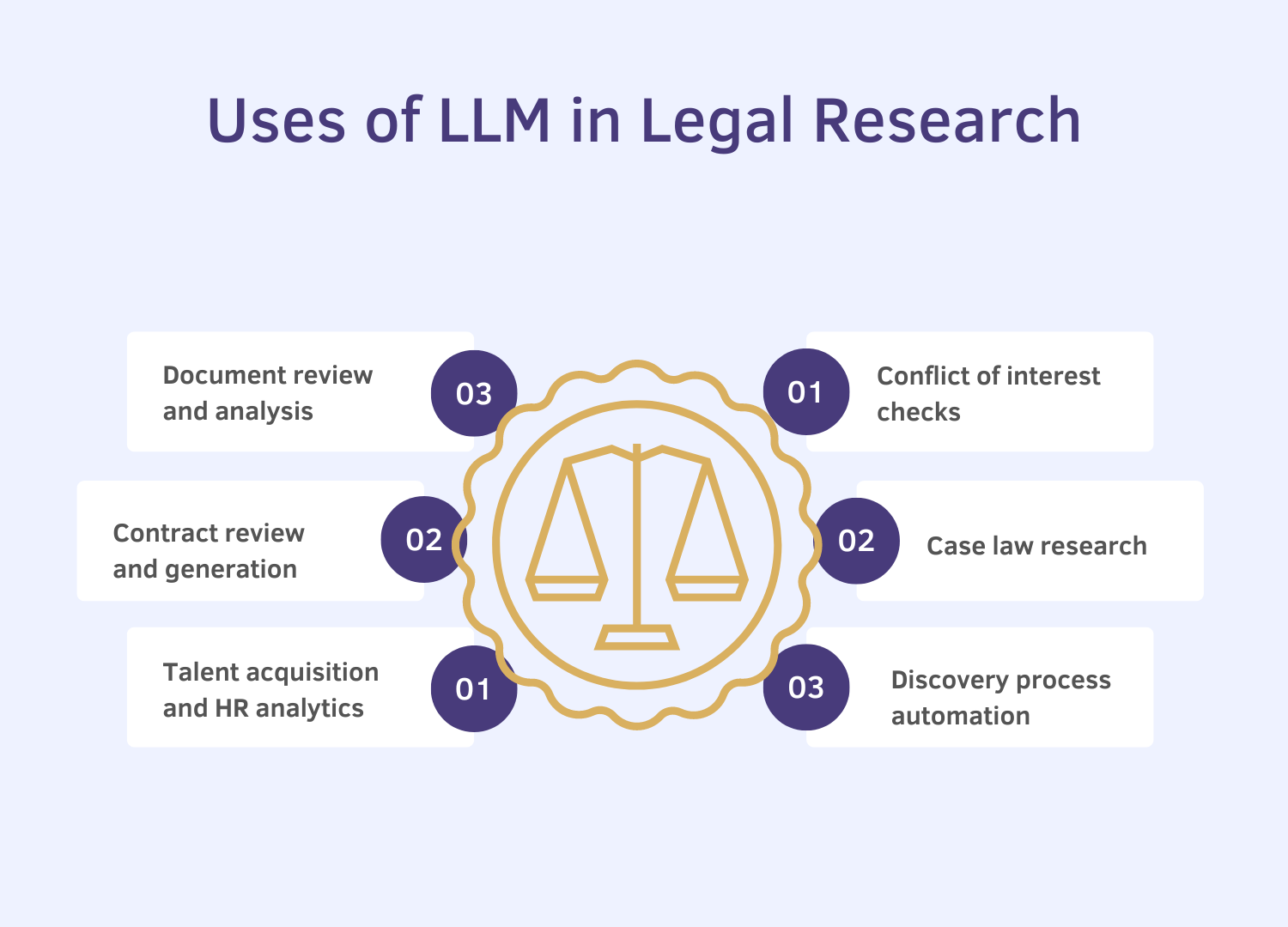Table of Contents
It’s not a question of “if” artificial intelligence will take the place of established law firms. The “when” is rapidly approaching, therefore it’s an issue of timing. Because legal research is heavily reliant on manual procedures and in-domain knowledge, it is also one of the most difficult industries to deal with. Such large language models have enabled changes in speed for the adopters while investigating and evaluating contracts, automating repetitive operations, and artificially infusing intelligence into analytics. Historically, the legal sector has lagged behind other industries in adopting new technologies. The use of AI in the legal industry is going to be impacted substantially. It will move it from a very traditionally conservative industry to a more innovative one.
Examining the difficulties and possibilities presented by the digital legal revolution shows that combining AI and LLM technologies is essential for differentiating oneself in the market and maintaining competitiveness in the legal industry. When talking about services linked to AI and LLM, it is important to take into account a number of the dynamics present in the traditional legal sector. These models use sophisticated natural language processing solutions and text production to improve productivity, accuracy, and decision-making. Deep learning architectures serve as the foundation for LLMs, which are trained on enormous datasets to comprehend, interpret, and produce human-like language. This automates repetitive work, assisting experts. This article examines the applications, advantages, difficulties, and potential effects of LLMs on the legal sectors.

LLMs’ Impact on the Legal Sector
Though a lot of legal duties can be expressed in terms of producing text, it’s important to keep in mind that large language models do not think as humans do. They are prone to novel and unexpected sorts of errors, committing mistakes that a human would not. This isn’t always a bad thing, though; in some applications, speed or creativity take precedence over correctness, and in those situations, LLMs are excellent resources for low-cost content creation. However, legal labor is highly regarded and valuable.
The legal services market is projected to reach a valuation of USD 952.29 billion globally by 2022, and it is projected to increase at a compound annual growth rate (CAGR) of 4.5% between 2023 and 2030. We believe that as a new kind of software infrastructure for legal research, LLMs will be essential to the future of our product. If our predictions come true, technology will significantly increase the efficiency and accessibility of legal work beyond anything that has ever been possible. However, human lawyers will still be essential in supervising and evaluating the work of Legal AI.
Opportunities After LLM Implementation in the Legal Industry
Competitive advantage: Organizations that use Legal AI and LLMs have a major edge over their rivals. These technologies give innovative law firms an advantage over competitors that only use traditional methods by enabling law firm modernization, such as quicker legal research, document analysis, and contract drafting.
Improved client service: LLMs and AI in the legal industry allow legal firms to offer their clients more effective services. By combining these technologies with data-driven insights and predictive analytics solutions, legal tactics can be guided toward better results and happier clients.
Scalability and cost-effectiveness: These are achieved by streamlining processes, minimizing manual labor, and allocating resources optimally through the integration of AI and LLMs. This supports growth and scalability by reducing costs and improving the capacity to manage a higher caseload.
Leverage The Power of LLMs in Modern Legal Practice
In what ways is technology changing the legal sector?
The speed at which technology is developing is astounding, and AI and LLMs have opened up a plethora of cutting-edge applications that improve and expedite several aspects of legal research. LLMs are transforming the way legal professionals approach their work, from accelerated document review to improved contract creation, talent acquisition, dispute resolution, and legal research.
We’ve compiled an extensive list of use cases where LLM-powered Legal tech solutions can boost productivity, accuracy, and efficiency in legal research.
1. Using LLMs to generate ideas: The next step in legal innovation
In legal research, brainstorming is where LLMs’ limitless potential shows. Entrusted with generating a range of viewpoints, these models possess the ability to reinterpret problems and formulate inventive approaches that have the potential to transform legal research and application. Legal teams may now generate ideas on a never-before-seen scale thanks to LLMs, and they can do it much faster because they are not constrained by the individual’s tendency toward narrow-mindedness.
There are numerous applications. LLM-powered Legal tech solutions can bring a level of creativity and foresight that was previously unachievable to a variety of tasks. These tasks include risk management procedures that foresee and neutralize potential legal threats, contract negotiation strategies that strike a balance between assertiveness and fairness, and the creation of legal arguments that are compelling to innovative legal interpretations.
But great innovation also carries a tremendous risk. There is a significant risk of hallucination, in which large language models create creative but factually incorrect work. The same qualities that make LLMs excellent collaborators in brainstorming also leave them vulnerable to producing information that, however convincing, might be founded on faulty logic or nonexistent precedents.
The key to mitigation is a two-pronged approach: first, strict limits that constrain the AI’s creative urges; second, a comprehensive vetting procedure that compares each AI-generated notion to established legal precedents and historical standards. Workflows for life cycle management (LLM) can incorporate retrieval-augmented generation (RAG) to apply additional mitigating measures. RAG augments an LLM with a knowledge base library to improve and augment the large language model outputs, producing outcomes that are more tailored for a particular topic or clientele. Legal departments may utilize the creative force of LLMs only by taking a methodical approach that guarantees innovation without sacrificing precision and dependability.
2. Authoring using LLMs: Creating documents more quickly
In every corporate legal department, authoring plays a crucial role in everything from the preparation of intricate legal documents to the drafting of complex contracts. In this field, large language models are proven to be effective resources since they can quickly produce legal clauses, write thorough documents, and enhance content development with smart recommendations. This skill greatly expedites the negotiating process, helps in memo drafting, and makes it easier to create clear, well-organized legal documents.
In contract law, where the creation of clauses and phrases can be customized to unique business needs while reflecting the most recent legal standards, the employment of LLMs for authorship is especially revolutionary. LLMs can absorb a great deal of information when writing internal memoranda. It guarantees that legal advice is thorough and takes into account all pertinent aspects. Applications of LLMs can also produce papers for arbitration or litigation, which can serve as a strong base for developing and refining legal arguments.
Challenges
The possibility of hallucinations, however, offers a moderate obstacle in this field. Since LLMs are responsible for producing fresh content, they may produce legalese or terminology that isn’t entirely compliant with existing laws or precedents. This calls for scrutiny. Moreover, although an LLM can provide a broad spectrum of legal terminology, its comprehension of context and nuances is not perfect. A system of thorough assessment by qualified legal experts is necessary to reduce these dangers. Each document produced by an LLM should be carefully reviewed. The terms and clauses are compared to current laws, contracts, and court rulings. Before the papers are finalized, a multi-tiered review procedure that evaluates LLM outputs at multiple stages can serve as a reliable filter to identify and fix any errors.
Attorneys skilled in complex knowledge management can leverage existing contracts, laws, and precedents to build tailored RAG knowledge base libraries. Alternatively, consider grouping prompts by substantive expertise for LLM outputs. By doing this, lawyers can have more control over the results, and mistakes or delusions should be easier to spot.
If their products are subjected to careful examination and confirmation, LLMs can be used efficiently for authorship within corporate legal departments, offering efficiency and a high level of support.
3. Text and document transformation: The boost to productivity
In the digital hallways of corporate legal departments, legal language models (LLMs) are turning into indispensable instruments for altering texts and documents, boosting productivity, and improving the understandability of complex legal information. These AI-powered tools are quite good at translating papers for cross-border legal practices, distilling lengthy legal texts into executive summaries, and fine-tuning wording in legal communications to conform to business policy and tone.
For example, large language models are capable of effectively summarizing long case law, allowing legal professionals to swiftly understand the main points of court decisions. They are also skilled at answering information requests (RFIs), where they can summarize the main points and any relevant legal ramifications. For busy legal teams, LLMs save important time by ensuring that the content and subtleties of legal advice are communicated accurately in memos.
Role of LLM
There are hazards associated with LLMs’ transformational potential, though. These jobs carry a low to moderate risk of hallucinations; summary texts may unintentionally leave out important details, and translations may lose subtleties that could cause misinterpretations. This is especially true in the legal field, where even the smallest detail can have a big impact. The implementation of a dual-review system is here. In this, the legal professionals and LLMs collaborate and critically examine each other’s work. They identify and mitigate these dangers. Furthermore, it’s critical to view LLMs as supporting instruments rather than the main source for legal text modification. This alternative method ensures that human oversight is applied to the final product for accuracy and contextuality, while still allowing the efficiency of LLMs to be utilized.
When used in conjunction with established review standards, legal tech solutions can greatly improve the document processing capabilities of corporate legal departments. In addition to increasing output, this strategic use upholds the strict adherence to accuracy and dependability that characterize the legal profession.

4. Legal research using LLMs: Large-scale, in-depth analysis
The body of precedents, regulations, and regulatory directives that make up corporation law serves as the cornerstone for legal strategy and compliance. LLMs have developed into effective generative AI tools for navigating this complicated legal environment, providing in-house legal departments with the capacity to carry out extensive study on a never-before-seen scale. They sift through mountains of legal literature to find pertinent cases, explain statutes, and provide analyses that shed light on important legal issues.
With data analytics solutions that can quickly access and analyze vast amounts of legal data, LLMs function as the modern equivalent of law librarians. This ability is quite helpful when it comes to activities like checking case strategy against precedent, interpreting statutes to create compliance frameworks, and making sure regulatory diligence is done in several jurisdictions. Legal tech solutions can be used by in-house attorneys to stay up to date on legal changes and to deliver solid legal advice based on the most recent and pertinent legal data.
Hallucinations
Even with their usefulness, hallucinations are still possible, however, they are rare when the right legal-focused LLMs are employed. This is because LLMs in legal research are more concerned with obtaining already-existing factual data than with producing original content. As we’ve recently seen with examples like the attorney’s use of LLM like ChatGPT for legal research in Mata v. Avianca, even with low risks, the implications of inaccurate information in the legal field can be profound, and those risks would increase if general consumer-facing LLMs are used for legal research.
To guarantee the dependability of LLMs in legal research, a verification methodology must be implemented. Legal conclusions made by LLMs ought to be cross-referenced with current legal analysis and verified using official legal databases. Furthermore, secondary confirmations by legal professionals serve as a safety net against potential oversight. It guarantees the accuracy and applicability of the material supplied by LLMs.
The judicious use of LLMs in legal research broadens the ability of legal departments to effectively manage challenging research projects while also enhancing the depth of analysis. By implementing effective mitigation measures, large language models (LLMs) can be utilized to conduct a thorough analysis of legal texts. It provides legal teams with complete and detailed legal insights.
5. Examining documents with LLMs: Meticulousness and accuracy
In a corporate legal context, document interrogation stands for the highest level of accuracy among the applications of LLMs. LLMs are utilized to carefully go through one or more papers, extract important information, point out differences between versions of the contract, mark clause modifications, and distill particular legal aspects required for well-informed decision-making.
This exact interrogation also occurs during the due diligence phase, when legal artificial intelligence evaluates papers to guarantee uniformity and compliance, and in litigation, when they help identify crucial information from a plethora of files. When there is little room for error and time is of the essence, their function is crucial.
The task’s specificity minimizes the likelihood of hallucinations. Instead of creating original content, the LLM concentrates on locating and delivering precise, accurate information that falls within a predetermined scope. Even with this modest danger, though, caution is still required because any mistake could have serious legal repercussions.
Although simple risk mitigation is crucial, controlled prompts with clear objectives must direct LLMs. Their conclusions must be verified by cross-referencing them with reliable sources. In-house legal personnel can support this strategy even more by implementing a human second review to validate the large language model work and make sure no detail—no matter how small—is missed. Different workflows could involve assigning different levels of relevance and risk to documents undergoing analysis. It would determine the degree of human intervention required to validate any LLM output.
Document interrogation is made into a process marked by diligence and precision thanks to the skill of legal professionals and the meticulous nature of LLMs. LLMs function with a high degree of accuracy in this well-calibrated setting. It gives legal departments dependable instruments to traverse the intricate corporate law landscapes.
Schedule a Demo To See How AI Can Transform Your Practice
The Risks to Operations and Ethics
People can save time by using AI and LLMs, but there are some worries and risks related to using responsible AI in professional services.
Court Opinion: Legal service providers must understand that, even in cases where generative AI and LLMs are employed for marketing, several courts and legal organizations forbid their use in professional activity. You should conduct a study to find out how AI and LLMs can and should be employed in your daily operations, depending on your jurisdiction. Guidelines on the use of generative AI are currently being developed by legal societies and courts worldwide, and new guidelines are being published daily.
Deep Fakes and Hallucinations: The ability of generative AI technology to fabricate case law, plagiarize, produce duplicate content, and deliver false or misleading information is one of the reasons courts are concerned about its application. It is imperative for any company wishing to integrate legal artificial intelligence into its marketing or business development endeavors to acknowledge and address this critical factor.
Compliance: Artificial intelligence (AI) may make it more likely for content to “cross the line” in terms of morality. For instance, an article or other piece of content may misrepresent a firm’s or lawyer’s legal permission to practice in a particular state. To make sure that all articles and case studies published by marketing or communications experts comply with local regulatory bodies’ applicable rules and regulations, a lawyer must review them all.
Chat Boxes: Should someone receive false information through an AI-generated chat box, businesses, and organizations may be held legally accountable. While chat boxes represent a genuine AI prospect, businesses must exercise caution when utilizing them as there is a potential risk.
Entering the Future of Legal Industry
Strategic vision and proactive measures are necessary to handle the upcoming upheavals and challenges the legal sector will confront as we enter a revolution in legal technology. To appropriately embrace learning and innovation, businesses should start by cultivating a culture of inquiry and adaptability. Encouraging employees to realize the potential of AI development and lifelong learning is essential for maintaining competitiveness, regardless of their background in law or technology.
Such a culture can be enabled through investment in inquisitive and ready-to-learn workers who can overcome people’s natural resistance to change. It will become very important to invest in the workforce for AI-savvy workers to design and manage these technologies, whether business analysts or developers. This will allow them to remain competitive in the legal market. By augmenting the competencies of internal IT staff and utilizing external resources, companies can initiate the process of creating solutions for sophisticated technical use cases.
The establishment of ethical frameworks that specify the acceptable integration of these technologies is essential for maintaining the industry’s credibility. It is important to modernize the legal system while maintaining its integrity. For this legislators, legal experts, and software developers must work together cooperatively. The legal sector is about to undergo a digital revolution. LLMs and generative AI solutions have the power to completely change the way legal services are provided. It is now imperative to embrace the disruption caused by legal AI to stay competitive and relevant in the legal environment of the future.
We Have The Capability to Simplify Your Complex Legal Tasks With AI
In summary
LLMs mark a revolutionary development in artificial intelligence that is creating previously unimaginable opportunities in some fields. These machine learning algorithms can improve automation, produce innovative content, and support research, but there are important issues to take into account given their exponential expansion. Concerns about data privacy, possible biases, moral quandaries, and the changing regulatory environment are just a few of the obstacles that face LLMs on their journey. We must remain steadfast in our adherence to moral standards, openness, and responsibility as we use the potential of open-source LLM. To make sure that these potent instruments enhance our lives and uphold our rights and values, open-source LLM must be developed and regulated responsibly.
A3Logics, an artificial intelligence development company, aims to direct LLMs’ future course so that innovation consistently complies with morality and the interests of humanity as they grow. By choosing us as your partner in legal software development service you can make the best of technology focused on client satisfaction.
FAQs
What is an LLM?
An LLM is a type of artificial intelligence model trained to understand and generate text from vast reams of data similar to how a human would. Examples include OpenAI’s GPT-4 and Google’s BERT.
How do LLMs improve legal research?
LLMs can quickly analyze large volumes of legal texts and find the information therein that is relevant, providing a concise summary and thus greatly speeding up the research time and workload of legal professionals.
Can LLMs understand complex legal language?
Yes, LLMs are trained on diverse datasets containing legal documents, enabling them to understand and generate text using complex legal language precisely.
How accurate are LLMs in legal research?
They are also highly accurate in searching for applicable legal information and summarizing such information. However, human scrutiny is still needed to ensure that the information is accurate and relevant in some legal contexts.
Can LLMs help with case law research?
Yes. LLMs can scour vast databases of case law, highlighting the most relevant cases on a particular matter. It also suggests probable precedents that could be applied to a present case.






